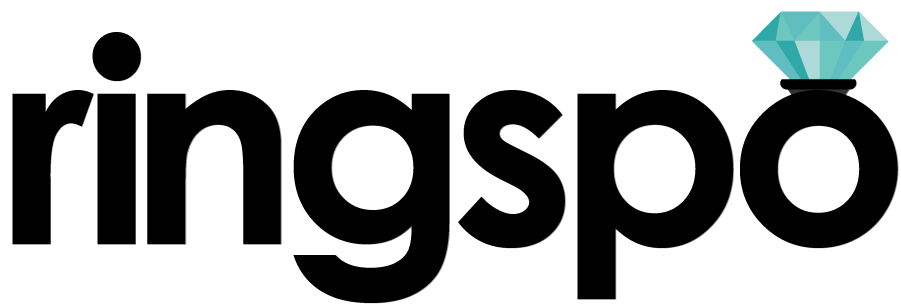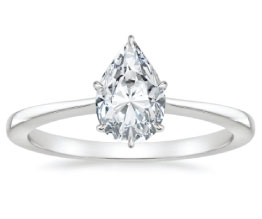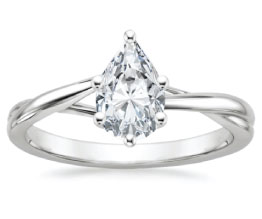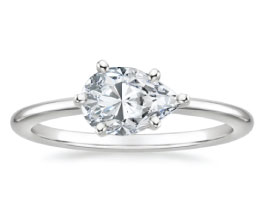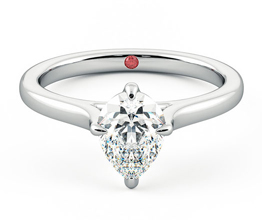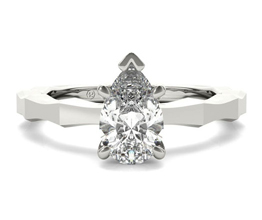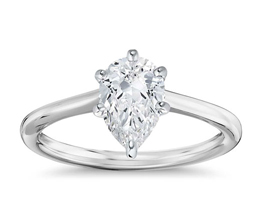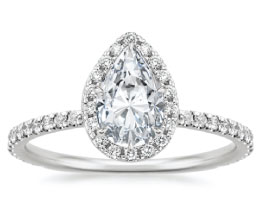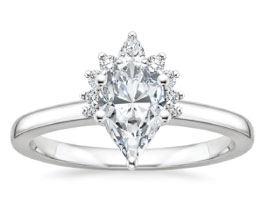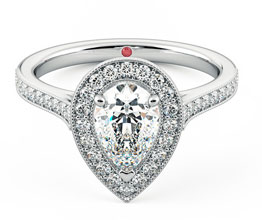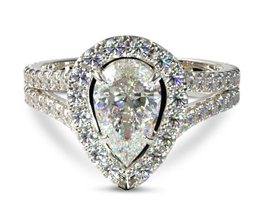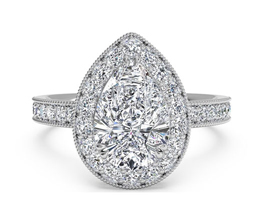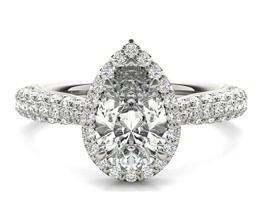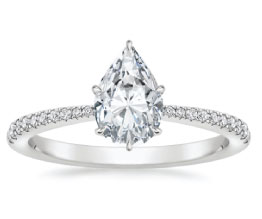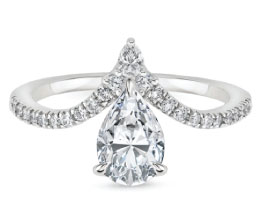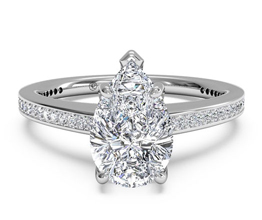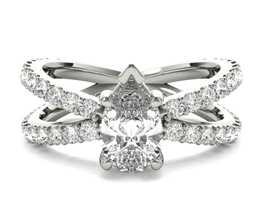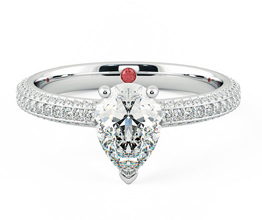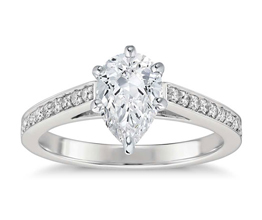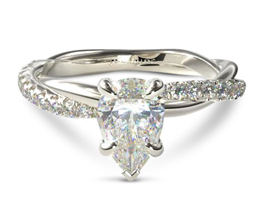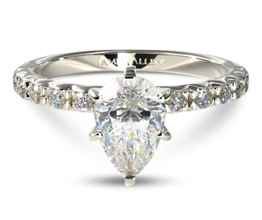Pear engagement rings
How to get the most beautiful pear shaped diamond and the best value
Ringspo is reader supported
Ringspo is reader-supported, which means we may receive a commission if you click a link to a retailer & subsequently make a purchase.
We feature links to several retailers to help readers find the one that is the best fit for them. Find out more about how Ringspo works here.
Pear shaped engagement rings are one of the most elegant choices when it comes to diamond rings.
But they’re also one of the trickiest shapes to buy.
On this page you’ll learn how to get a beautiful pear diamond that sparkles brilliantly, while avoiding the common mistakes that many people make when buying a pear engagement ring.
Read on and you’ll learn:
- What’s good about pear engagement rings
- What’s bad about pear engagement rings, and how to avoid it
- How to find the most beautiful pear diamond
- Pear engagement ring setting styles
- Recommended diamond specs to get the most beautiful stone possible
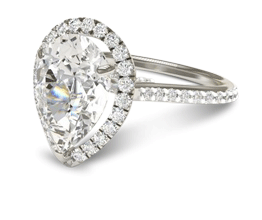
An Introduction To Pear Diamonds
First, a little background, so you know what you’re looking at.
Pear diamonds are a brilliant cut
Many people ask: “do pear diamonds sparkle?”
Pear diamonds are a brilliant cut, which means that they are cut to maximise sparkle.
When you look on a diamond grading report, you’ll see this:
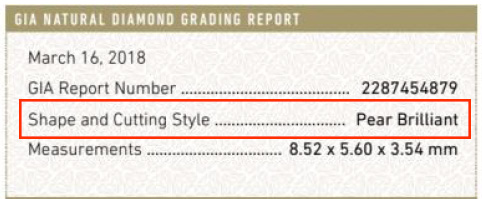
They’re actually a combination of two cuts – the round brilliant and the marquise:
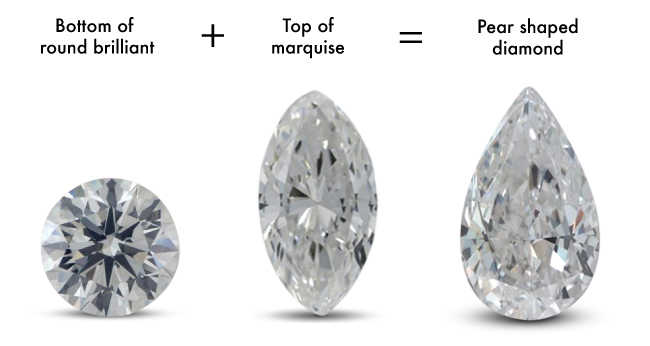
What this means is that pears have been cut for each of he individual facets with the aim of sparkling as much as possible.
Pear diamonds are a ‘fancy cut’
Any diamonds that aren’t a round diamond are known as a ‘fancy cut’. And the pear is just about the fanciest of them all.
The GIA, the most widespread and most trusted of diamond assessment authorities, only issues grading cut quality reports for round diamonds.
What does this mean for you?
Any cut grades that you see on a retailer’s website are based on the retailer’s own estimation, rather than any impartial grading.
This means that you should take retailer’s gradings with a pinch of salt. The pear diamond buying guide below shows you how to make an informed decision on your stone, to make sure you get a beautiful diamond that sparkles brilliantly.
Pear diamonds are also known as ‘teardrop diamonds’
A traditional name for pear shaped diamonds was ‘teardrop diamonds’, due to their shape.
This name has fallen out of favour somewhat, and most retailers and jewelers now refer to them as pear diamonds.
How to wear a pear shaped ring
Pear diamonds should be worn with the point towards the end of the finger.
While a pear engagement ring could be worn either way, traditionally they are worn with the point towards the end of the finger.
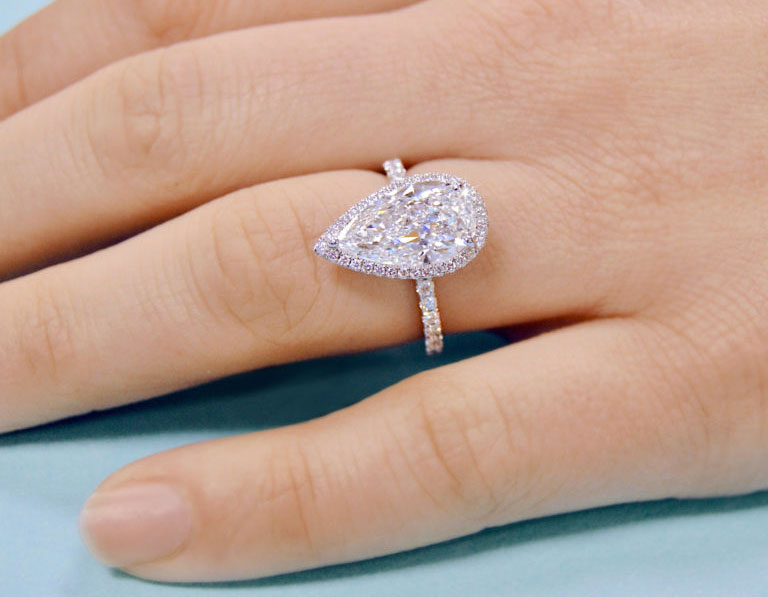
The advantage of this is that they make a finger look longer and slimmer. However, if you want to wear your ring the other way then that is equally acceptable.
Pear shaped engagement ring meaning
Women who choose or wear pear shaped diamonds are said to be strong individuals, due to pears being an uncommon shape.
Pear diamond wearers are also said to be traditionally romantic, with the teardrop shape indicating that there will be tears of joy within a relationship.
There are no official ‘meanings’ of diamond shapes, but there are some traits that are commonly ascribed to those who choose diamond shapes.
But ultimately, pear diamonds are and beautiful and elegant stone, and a great choice for those who are looking for something a little different.
Pear shaped diamonds pros and cons
Pro: Pear diamonds are less expensive
Pear diamonds are in less demand than other shapes.
The best thing about this?
Lower demand means lower prices.
Let’s check out the price against a round brilliant diamond:
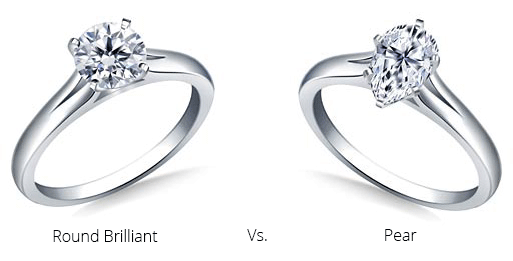
We’re going to look at a typical price difference at one of my recommended retailers for a diamond with the following stats:
- 1 carat
- Color F
- Clarity VS1
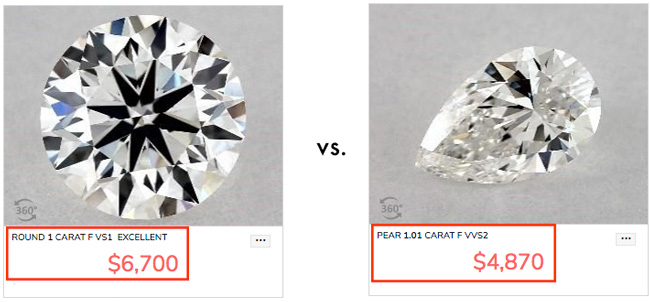
The table below shows what this really means in terms of %:
| Shape | Price (US$) | Difference (US$) | Difference (%) |
|---|---|---|---|
| Round brilliant | $6,700 | ||
| Pear | $4,870 | -$1,830 | -27.3% |
The pear diamond is 27.3% less expensive than the round brilliant.
That’s a whole quarter!
And, while some fancy shapes offer reduced scintillation and sparkle compared to the round brilliant, a pear engagement ring will sparkle nearly as well as other brilliant shapes.
Pear diamond pro: they look large for their carat weight
Pear diamonds can also appear larger than other shapes at the same carat weight because they have more ‘spread’.
If we compare a 1 carat round brilliant diamond vs. a 1 carat pear diamond, we can see that while the pear diamond is slightly less wide than the round brilliant diamond, it is much longer, which gives the impression that it is larger:
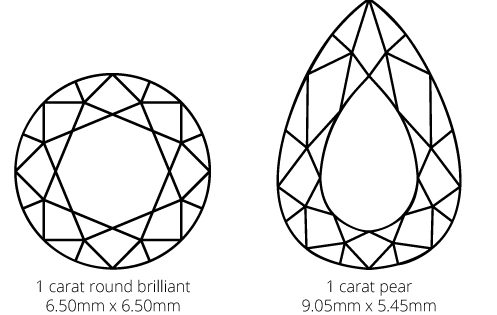
Pear diamond pro: they are flattering to the finger
Pear diamond’s elongated shapes are flattering to any finger, making them appear longer and more elegant. This is especially beneficial for people who have small hands or shorter fingers.
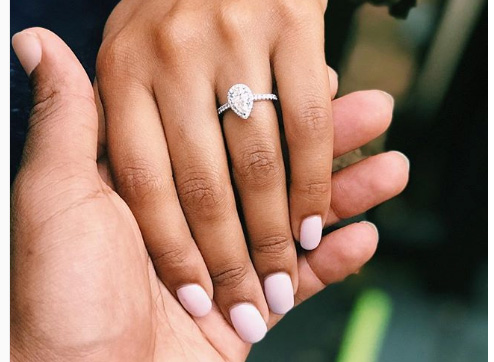
What’s bad about pear diamonds?
Pear diamond con: a large number of pear diamonds have a ‘bow tie effect’
The biggest negative effect of pear shaped engagement rings is the same negative that affects all elongated diamond shapes, including the marquise and the oval.
The ‘bow tie’ effect.
The bow tie effect is a dark shape that appears in the center of the pear diamond as light is reflected off the bottom of the stone and out of the sides.
From certain angles, no light is reflected back up through the top of the ‘table’ of the diamond. This results in two triangular dark shapes appearing in the center of the stone:
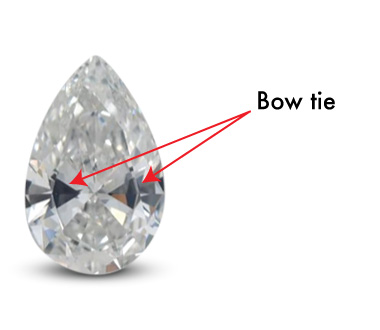
This is the dreaded bow tie.
Unfortunately all pear shapes will have the bow tie effect to some extent, but it can be minimised. Find out how in the pear diamond buying guide below.
Pear diamond con: they show warm / yellow colors more easily
In general, white is seen as the most desirable color for diamonds. It’s the rarest and most expensive.
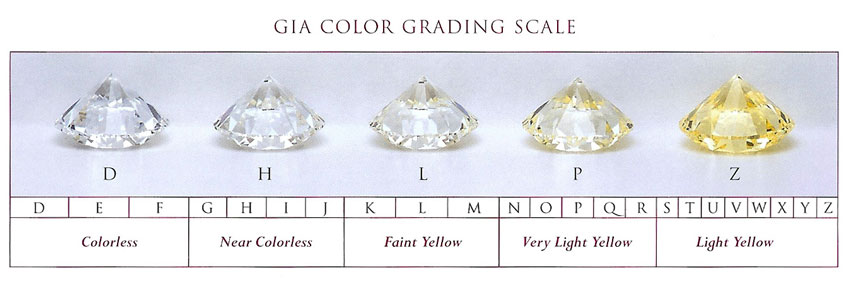
As you get further away from white, most diamonds tend to pick up ‘warmer’ yellow tones. Sharp points on diamonds concentrate the color, making it easier to pick up these warmer tones.
Diamonds with ‘brilliant cut’ facets are great at disguising the true colour of the stone because the light that is reflected back to your eyes is ‘chopped up’, hiding any warmer tones behind sparkle.
Pear diamonds benefit from this effect at one end only – the round end. The other end isn’t nearly so good at reflecting light back, so it’s easier to see the actual colour of the stone.
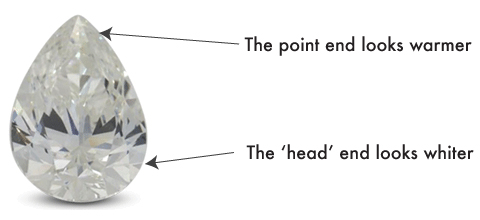
Pear shaped engagement ring settings
Pear shaped engagement rings come in a wide variety of setting styles and in this section we’ll take a quick look at some of the most popular. If there’s a style that tickles your fancy, just click through to find out more, as well as see loads more options too.
Solitaire pear engagement rings
Solitaire pear shaped diamonds rings are classic, simple and elegant. As well as allowing the most light to enter the center stone, meaning the diamond will sparkle as much as possible, they’re also pretty wallet-friendly, as they don’t have any fancy workmanship or extra precious stones to bump up the price.
Pear diamond solitaire rings hold the stone secure with four or five prongs around the edge of the stone and then a V-shaped prong at the bottom which holds the stone but also provides a measure of protection for the fragile point.
Halo pear diamond engagement rings
Halo settings, which surround the stone with a ‘halo’ of smaller diamonds, making the whole setting appear much more significant in size.
Choosing a halo pear diamond engagement ring is one of the best ways to make a ring look as big as possible, while the surrounding stones also give the delicate edges of the pear diamond a measure of protection.
Pavé pear diamond engagement rings
Pavé pear shaped engagement settings are a great way to add some extra sparkle to your engagement ring. Each of the micro diamonds that are set into the band catch the light at a slightly different time to the center stone, making the band shimmer.
Pear shaped diamond buying guide
In this section we’re going to look at the 4 Cs for pear diamonds, plus throw in some extra information too, to make sure you get the most beautiful pear diamond possible.
- Cut
- Color
- Clarity
- Carat weight
Plus, I’m going to talk you through the four extra Cs that you need to think about when buying a pear diamond engagement ring.
- Certification, and why it’s important
- Cost, and how you get the most value
- Choice, and why it’s especially important for pears
- Confidence, and how to be sure of your buying decision
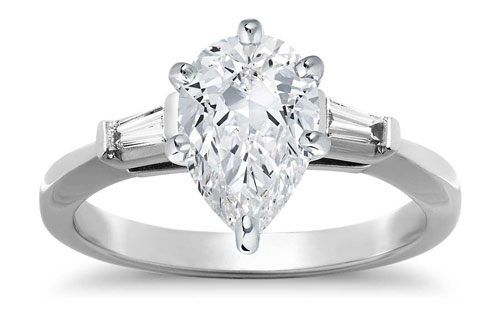
Pear diamond cut quality guide
Pear diamonds are a brilliant cut, which means that its important that the proportions are optimised to reflect as much light as possible:
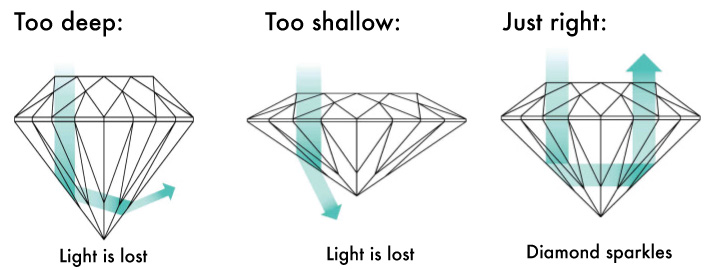
Unfortunately, unlike a round brilliant diamond, there are there are no fixed ‘ideal proportions’ for pear diamonds, which can make it difficult to find a great diamond.
But, if you know what to look for, you could find the most beautiful pear out there.
One that sparkles brilliantly that reflects as much light back to your eyes as possible.
Ideal pear diamond shape
There is a definite outline of a pear that you should be looking for.
The curved lobe of the stone should be a semicircle, with no straight lines or squared off ‘shoulders’. This shape looks better, but is also more likely to reflect light back to your eyes and sparkle.
The point of the stone should be in a direct line from the center of the table and the top of the lobe.
Any deviation will mean that light is reflected in off directions and out of the side of the stone, rather than back out of the top as scintillation.
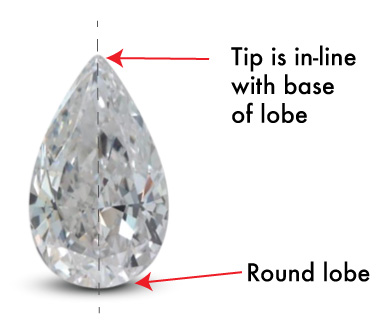
Lastly, the pointed end should not be too broad.
Some pear diamonds have too broad a tip
Some diamond cutters leave the tip at the top of the stone very broad to increase the carat weight of the diamond at the expense of the beauty of the stone:
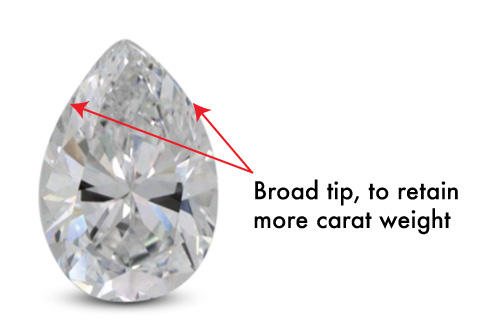
This is often done to ensure that the pear diamond reaches a ‘magic weight’ e.g. 1 carat. However, it also makes the stone look more egg-shaped than teardrop-shaped.
Definitely not as appealing.
Some pear diamonds have overly-square shoulders
Another way some diamond cutters try and increase the carat weight of a pear shaped diamond is to have square shoulders at the bottom of the stone:
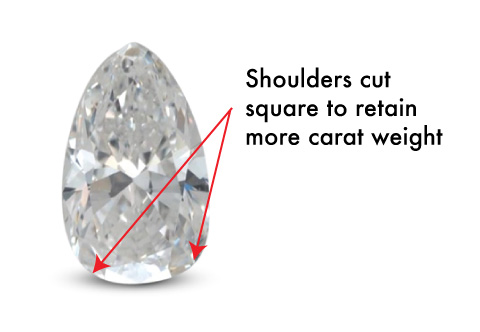
Again, this results in a less beautifully-shaped pear diamond.
Pear diamond ratio should be close to 1.5
Length / width ratio is a pretty simple concept.
It’s the ratio beween the length and the width. Voila:
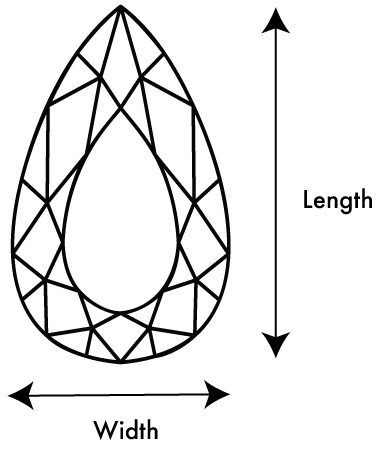
The classic L/W ratio for pear shaped diamonds is 1:1.5
This means that stone is one and a half times as long as it is wide.
Some people prefer longer pear stones, but I’d recommend keeping it under 1:1.75 or the stone is likely to look overly long and skinny.
Equally, going below 1:1.4 means that the stone may look a little squat and dumpy.
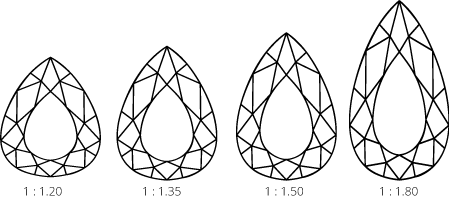
There are also two primary characteristics you want to pay attention to when looking at proportions.
These are depth percentage and table size which are both expressed as percentages in a grading report.
Pear diamond depth percentage
Depth percentage is the depth of the diamond as a percentage of the width of the stone.
This is extremely important for pear shaped diamonds as it affects the amount of light that is reflected back off the inside of the stone and back to your eyes, but also how visible the ‘bow tie’ effect is.
Unfortunately the bow tie effect can’t be eradicated completely, but by selecting a pear diamond with a depth % in the excellent range, below, you’ll reduce the bow tie, while keeping as much sparkle as possible:
| Excellent | Very good | Good |
|---|---|---|
| 56% – 66% | 54% – 72% | 52% – 76% |
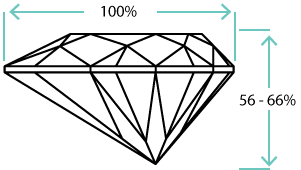
Even when using these ratios, a visual inspection of each pear diamond is essential.
Pear diamond table percentage
Table percentage is the width of the top ‘table’ of a diamond (the flat are on top) expressed as a percentage of the total width of the stone.
Again this is an important ratio because the proportions here will affect how light is reflected within the stone and the amount that it sparkles. Look for:
| Excellent | Very good | Good |
|---|---|---|
| 54% – 64% | 52% – 66% | 50% – 68% |
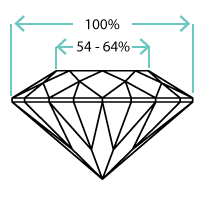
Pear diamond color recommendation
Ideally you want your diamond to look as white as possible.
But at the very top end of the color scale, it’s very difficult to see the difference between the colors. If you aren’t careful you can spend money on something that makes no difference to how the stone looks.
Because the colour of the stone can be concentrated at the pointed end of pear diamonds, I recommend going quite high on the colour scale.
Choose a G color grade for your pear shaped diamond will mean that no warmer tones are visible.

Going lower than this means that yellow tones may be visible in the stone.
Of course, you can go higher than this if you want, but the very highest colour gradings are mainly because people want to have the highest grade they can – it makes little difference to the actual appearance of the stone.
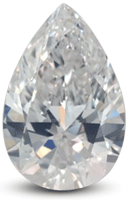
E color – very white, but very rare and therefore expensive
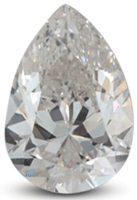
G color – a great mix of color and good value
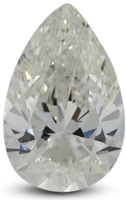
I color – warmer tones clearly visible
Pear diamond clarity recommendation
The clarity scale for diamonds runs from ‘flawless’ at the top, to ‘included’, at the bottom:

Like with color, one end of the pear cut diamond is great at disguising minor inclusions, and the other is not so great at it.
So, if a pear diamond does have inclusions, then their location in the stone will make a huge difference to how visible they are.
If they’re at the round end then they may be hidden behind the sparkle and scintillation of the stone.
If they are at the point of the stone then they may be hidden by the ‘crushed ice’ effect, but this is usually less effective at hiding the inclusion.
However, it’s only possible to tell this by actually examining the stone. Again, this is where Brilliant Earth and James Allen are great options.
My recommended minimum clarity grade to ensure that a stone is eye clean is VS2.

Even when choosing a VS2, you do need to inspect the stone to ensure that there are no inclusions under the table which could be seen with the naked eye:
Pear diamond carat weight
Carat weight is something that people often get overly hung-up on. They want to choose a stone with a certain carat weight, even if it means that they end up making sacrifices on other, more important attributes of the ring.
The relationship between a diamond’s carat weight and its visible size isn’t always a direct one. When we judge a diamond’s size, we look at it from the top – known as the ‘face up’ position in the jewelry trade. However, much of the weight of a diamond is actually carried on the bottom half of the stone, where it can’t be seen.
The images below show the difference in size for pear shaped diamonds at a range of carat weights:
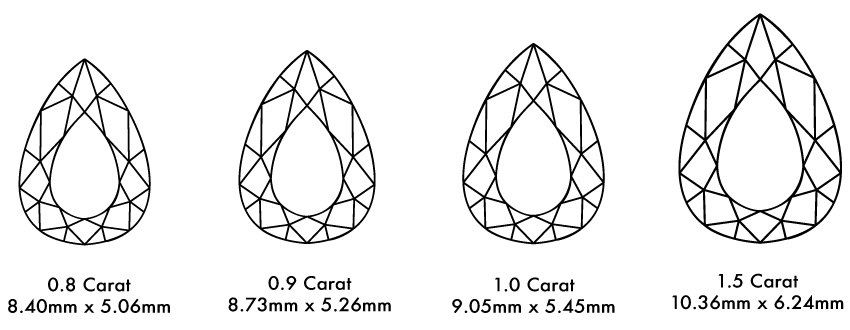
Hopefully you can see that increasing the carat weight doesn’t necessarily translate into a much visibly larger diamond. Changing the size from 0.8 carat to 1 carat is an increase in width of less than 0.4mm – less than 10%. However, the difference in price will be much more significant – an 80% increase.
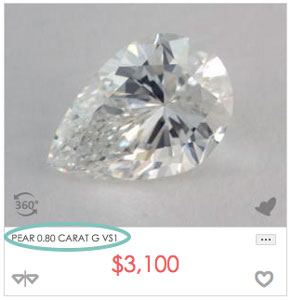
Check out today’s prices for a 0.8 carat Pear shaped diamond on James Allen
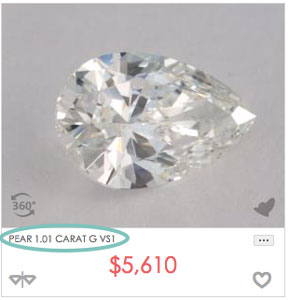
Compare to today’s prices for a 1 carat pear diamond here
The priority that you place on diamond carat weight and how bit you want to go is totally up to you. However, my recommendation is that you definitely don’t make it the most important attribute when choosing your engagement ring. Get the setting you love, find a diamond with a great cut that is going to sparkle brilliantly, make sure that it is eye-clean and has a good color and then see what carat weight you can fit into your budget.
A well-rounded diamond with excellent sparkle will much much more impressive than a big stone with obvious flaws.
In the above sections we’ve learned about the core 4 Cs of pear-shaped diamonds:
- Cut
- Color
- Clarity
- Carat
But as mentioned earlier, there are also 4 other Cs to consider:
- Certification
- Choice
- Cost
- Confidence
Pear diamond certification
The fifth C, and a very important one too. When looking at any diamond, you need to ensure that any diamond that you’re looking at is a ‘cert stone’, which means that it has been assessed, graded and coded with a laser by an independent lab.
Each certificate has a unique report number and detailed information about the stone, covering the four Cs, the height, depth and other info.
As well as providing assurance that the stone that you’re buying is the quality that you are paying for, a certificate also proves what you’re buying is not a substitute.
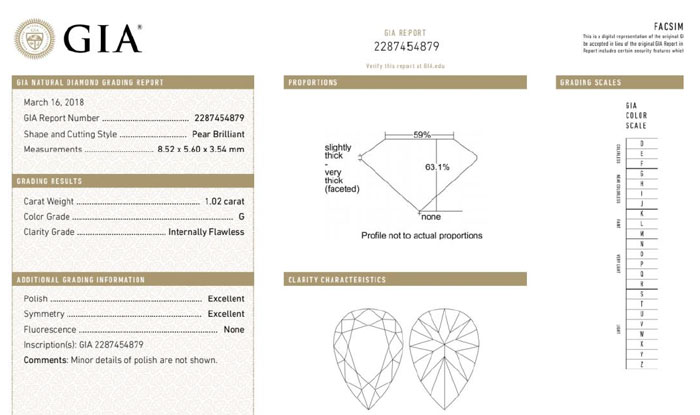
The lab to trust and to look for certification from is the non-profit Gemological Institute of America (GIA). It’s the most internationally recognised and generally seen as the most impartial of all of the gem labs.
The reason that the GIA is so well respected is because most others labs are part of trade bodies that contain jewelry retailers, or are ‘for profit’.
While the GIA is very consistent with its gradings, the others have a reputation for being overly generous. What the GIA say is merely a diamond with a ‘good’ cut, maybe be graded ‘excellent’ by another lab, with an excellently large price to match.
Diamond certificates are what makes buying online safe and the best way to get a fantastic diamond at the lowest price. Knowing that each diamond you’re considering has been measured and graded by independent experts allows you to make an informed decision. You can take your time to consider the differences between diamonds and make sure you choose what experts have graded as the best stone, meaning that you get your perfect engagement ring at the best possible price.
Pear shaped diamond engagement ring Cost
Earlier we learned that pear diamonds are significantly less expensive than round brilliant diamonds.
But how do they compare to other shapes?
I looked at one of the jewelers from my recommended retailers section and conducted a quick test – keeping all the other characteristics of the diamond (colour, clarity and carat) the same and only changing the diamond shape.
- Cut: Excellent
- Color: G
- Clarity: VS2
- Carat: 1
The results are below:
| Name | Shape | Price (USD) | Difference (USD) | Difference (%) |
|---|---|---|---|---|
| Round | $5,434 | 0 | 0 | |
| Oval | $4,180 | -$1,254 | -23.1% | |
| Pear | $4,150 | -$1,284 | -23.6% | |
| Princess: | $4,072 | -$1,362 | -25.1% | |
| Marquise | $4,030 | -$1,404 | -25.8% | |
| Heart | $4,028 | -$1,406 | -25.9% | |
| Asscher | $3,650 | -$1,784 | -32.8% | |
| Radiant: | $3,520 | -$1,914 | -35.2% | |
| Emerald | $3,440 | -$1,994 | -36.7% | |
| Cushion: | $3,240 | -$2,194 | -40.4% |
Pear diamonds come out as the third most expensive shape of diamond on this table.
But it’s important to remember that this is just a comparison of one particular combination of specifications.
When you are looking for your stone, the results may differ.
But what is important to remember is a pear will always offer considerably more value than a round brilliant diamond.
Pear diamond Choice
As pear diamonds are less common, most jewelers will have a very small selection to choose from.
In fact, many jewelers will have none at all on site.
This means that you may have to wait for them to request diamonds that meet your requirements from their suppliers.
And when they do come in, they may have ugly bow ties, overly-square lobes or any of the other issues that are present in a high proportion of pear shaped diamonds.
It can be a slow and frustrating experience.
But there is a better way:
Online retailers have thousands of pear shaped diamonds to choose from:

This means that you can filter through a large number of stones until you find the one that is right for you.
My top recommendation for pear shaped diamonds can be accessed here, with the proportions of the diamonds already set-up and ready to go.
Recommended pear diamond specs
These specs are the minimum that we recommend to ensure that the diamond on your pear diamond engagement ring looks fantastic.
You can of course go higher than these specs, if your budget allows, but for many of the characteristics you are paying for improvements that are very difficult, if not impossible, to see by the naked eye, especially when mounted in a ring setting.
| Clarity: | VS2 |
| Colour: | G |
| Symmetry: | Very Good |
| L/W ratio Depth %: Table %: | 1.75 – 1.96 56 – 66% 54 – 64%Good |
